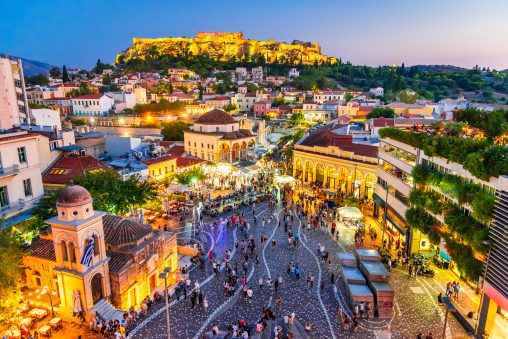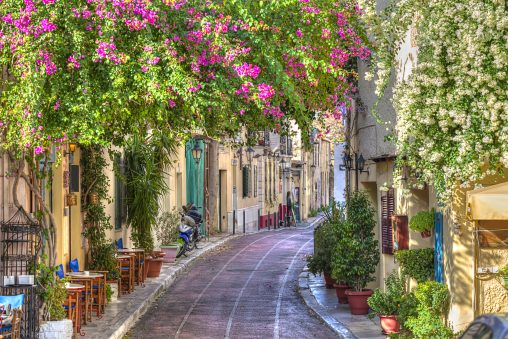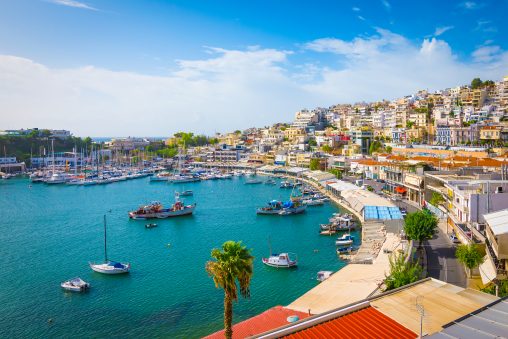Athens – spicy cradle of Europe

Athens is the venerable cradle of civilisation in Europe – the former city state that gave us the dream of democracy (a Greek word), but visit it today and you will find it to be a lively, spicy Mediterranean city with a touch of the Middle East.
Athens may be somewhat overlooked at times, tucked as it is into the south-eastern corner of Europe, but it is a great metropolis and a city of many firsts. The mother of European democracy was once a powerful city state that brought forth many legendary intellectuals and artists such as Plato and Socrates. As the southernmost capital in Europe it is also the hottest on the continent, as you will notice if you visit in summer.
One of the oldest cities in the world, Athens is an original, ancient metropolis (another Greek word), and while in classical times its population swelled well over half a million, now that number is almost seven times as high, putting the Greek capital right up there with Madrid and Rome in terms of size. A place that big naturally sprawls over several distinct districts, and Athens is certainly a city with local flavour.

Classic sights
But before you delve into lively flea markets off little squares or hit the cafés and nightlife spots of Athinai’s suburban areas, the classic thing to do is to admire its stunning monuments straight out of the glory of Ancient Greece. You see, we stand in awe of Rome and its might, but much of Rome was but a more militaristic copy of Greece. Indeed, the Romans copied Greek architecture, culture, art, theatre, uniforms, even their religion and pantheon – right down to even emulating some elements of their democracy.
In this way, Poseidon became Neptune, Zeus became Jupiter, and Rome’s famous palaces and public buildings were modelled on original versions that still stand proudly in Athens. The most obviously eye-catching of these is of course the Acropolis, the three-hectare large citadel complex that overlooks this sea of buildings from its limestone outcrop 150 metres above sea level. In its earliest form, the Acropolis dates back almost 3,000 years!
Easily the most iconic part of this wonder of the classical world is the Parthenon, an ancient temple that defines the very concept of early classical and later Neoclassical architecture based upon the well-known Greek column varieties. When it comes to the chance of strolling amid the giants of the distant past, only Rome itself equals Athens within Europe, but there are other historic sights to behold as well, including a whole collection of Neoclassical palaces and museums inspired by Greek independence in the 19th century.
Classical Greece became part of the Roman Empire, then the seat of the Eastern Roman Empire, with its capital not in Athens but in Constantinople (today’s Istanbul), before the latter was renamed Byzantium during the post-Roman Byzantine period. It all (including Athens) fell to the invading Turks in the Middle Ages, and so once-proud Greece lost its independence for several centuries before regaining it with French help in the 1830s.

More than history
But there is more than history alone to Athens. Veer away from the tourist-filled sights and find your way down to the main squares and shopping streets, such as Ermou, and Syntagma Square. Now you’re in the heart of the city, surrounded by the unmistakable bustle of Athens, as well as famous monuments such as the National Gardens, the old parliament and royal palace, as well as numerous museums and luxurious hotels. Don’t miss the iconic Evzones soldiers guarding the Tomb of the Unknown Soldier, they’re pretty unique.
Let the lively bustle flow over you like a wave and you will feel a sense of familiarity with a Spanish city, although the scent of Greek cooking, coffee and spices wafting over from the plentiful restaurants and cafés has a slightly more exotic feel to it. Make your way to Monastiraki, an atmospheric district full of shops and flea markets where you’ll also have a chance to sample traditional dishes such as lamb Kleftiko, Moussaka and shawarma-like Gyros, washed down with local wines and complemented with Baklava and strong Greek coffee.
In the evenings, take a cab to Psiri, an elegant part of town that’s know for a lively dining, café society and live music taverna scene. In fact, you’d do well to book a hotel here, and stroll through the cobbled streets of Páka and Anafiotika in search of charm and a hearty lunch. Athens is also a coastal city, so take a train to one of the many beachside areas, such as Palaio Faliro and Alimos, of course not missing out on the lively pleasures of Piraeus, the harbour city of Athens.

History is all around, from the ancient temples and columns that adorn this capital and its pine-clad hillsides right up to near the beaches. The hills also provide spectacular views over Athens and the Saronic Gulf to which it extends. From here, it’s but a short daytrip to Delphi in the nearby mountains. You won’t be advised to hike to the top in a quest for the cryptic answers provided by the legendary Oracle, but taking in the beauty and antiquity of this spot is more than enough excitement for most visitors.
For jet-setters, there are also cruises and catamaran trips along the shore to the surrounding bays, islands and myriad of coves and beaches. If you round the peninsular form of Attica you could sail to Thermopylae, where a Greek alliance defeated a massive Persian invasion against all odds. You know, as in ‘300’ – as seen on movie screens.
From ancient Greece to Byzantium, the Romans and Ottoman Turks to more recent history, Athens is a city that will enthral. But beware, this is not an open-air theme park, it’s very much a live Mediterranean city with an exciting touch of Eastern flavour.
First published in Essential Magazine
Images: Shutterstock












